


Compound corymb: A branched corymb is called Compound corymb. All flowers appear at the same level to form convex or flat topped racemose inflorescence.

There are two types, namely corymb and umbel.Īn inflorescence with shorter pedicellate flowers at the top and longer pedicellate flowers at the bottom. Inflorescence with reduced growth of central axis. It is also called Compound raceme or Raceme of Racemes. Example: Amorphophallus, Colocasia.Ī branched raceme is called panicle. Entire inflorescence is covered by a brightly coloured or hard bract called a spathe. Usually female flowers are found towards the base and male flowers are found at the apex. Example: Acalypha hispida, Prosopis juliflora.Īn inflorescence with a fleshy or thickened central axis that possesses many unisexual sessile flowers in acropetal succession. Pendulous spikes with a long and drooping axis bearing small unisexual or bisexual flowers. Tepals reduced to colourless scaly leaves (lodicule). Each sessile flower has a lemma (bract) and a palea (bracteole). Sessile flowers are formed in acropetal succession on the axis.Ī pair of inflorescence bracts called glumes is present at the base. The Inflorescence is with branched central axis. Spike is an unbranched indeterminate inflorescence with sessile flowers. The inflorescence with an unbranched main axis bears pedicellate flowers in acropetal succession. The following types are discussed under main axis elongated type. The axis of inflorescence is elongated and contains pedicellate or sessile flowers on it. It is further divided into 3 types based on growth pattern of main axis. Old flowers are at the base and younger flowers and buds are towards the apex. The central axis of the inflorescence (peduncle) possesses terminal bud which is capable of growing continuously and produce lateral flowers is called Racemose inflorescence. Inflorescence which do not confine to these patterns Inflorescence of some plants show a combination of indeterminate and determinate pattern. Inflorescence may also be classified based on branching, number and arrangement of flowers, and some specialized structures. Where does it arise?īased on Branching Pattern and Other Characters Observe the inflorescence of Jackfruit and Canon ball tree. Example: Theobroma cocoa, Couraupita guinensis. Inflorescence developed directly from a woody trunk. Inflorescence presents in the axile of the nearest vegetative leaf. Inflorescence grows as a part of the terminal shoot. Have you ever noticed the inflorescence arising from different positions? Where is the inflorescence present in a plant? Apex or axil? Based on position of inflorescences, it may be classified into three major types. The grouping of flowers in one place gives a better attraction to the visiting pollinators and maximize the energy of the plant. But an inflorescence is a group of flowers arising from a branched or unbranched axis with a definite pattern.įunction of inflorescence is to display the flowers for effective pollination and facilitate seed dispersal. Have you seen a bouquet being used during functions? Group of flowers arranged together on our preference is a bouquet. Inflorescene Types and its Characteristics


 0 kommentar(er)
0 kommentar(er)
